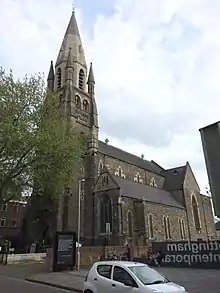High Pavement Chapel
High Pavement Chapel is a redundant church building in Nottingham, Nottinghamshire, England. It is now the Pitcher and Piano public house and is Grade II listed. It was built as, and for most of its existence operated as, a Unitarian place of worship.

| High Pavement Unitarian Chapel | |
|---|---|
 Unitarian Chapel on High Pavement, now the Pitcher and Piano public house | |
| Country | England |
| Previous denomination | Unitarian |
| Architecture | |
| Heritage designation | Grade II listed[1] |
| Architect(s) | Stuart Colman |
| Completed | 1876 |
| Closed | 1982 |
History
By August 1662, under the Act of Uniformity, two Nottingham ministers, John Whitlock and William Reynolds, had been deprived of their living at St Mary's Church, Nottingham and a third, John Barret, of his at St Peter's; the three men left town to comply with the Five Mile Act 1665. However, they continued to preach in the area, including houses in Nottingham's Bridlesmith Gate and Middle Pavement. This led to the foundation of a permanent chapel in High Pavement in 1690.[2]
By 1735 the congregation had established itself as liberal (in the tradition of English Presbyterianism) and in 1802 as Unitarian. In 1758 the appointment of a new junior minister, Isaac Smithson, caused a schism. The senior minister withdrew to a new chapel in nearby Halifax Place. This schism lasted until 1775 when the two congregations merged. The original chapel was considerably rebuilt in 1805.
In 1864 the congregation opened a daughter church, Christ Church, Peas Hill. This survived until 1932.
The current building was opened in 1876, built to a design of the architect Stuart Colman, of Bristol. It was used as a place of worship for Unitarians until 1982. It was then converted into the Nottingham Lace Museum, but this venture proved financially unviable. The building was then converted to its current use, as a Pitcher and Piano public house.[3] The current congregation, Nottingham Unitarians, affiliated with the General Assembly of Unitarian and Free Christian Churches, are now based nearby at 3 Plumptre Street, Nottingham NG1 1JL, a former lace factory where items of lace were finished.[4]
Stained glass
- East window 1904, by Morris & Co., to designs by Philip Burne-Jones
- North aisle war memorial window, 1925, by Kempe & Co
- Sunday School memorial window, 1906, by Henry Holiday
- North transept north window 1890, by H Enfield
Ministers
- John Whitlock, M.A. 1662–1708
- William Reynolds, M.A. 1662–1698
- John Barret, B.A. 1662–1713
- John Whitlock junior 1689–1723
- John Hardy 1714–1727
- Nathaniel Whitlock 1729–1739
- Obadiah Hughes[5] 1728–1735
- Samuel Eaton, 0.0.1737–1759
- Joseph Evans 1754–1758
- Isaac Smithson 1758–1769
- John Milne 1759–1772
- Thomas Brushaw 1769–1772
- John Simpson 1772–1777
- George Walker, F.R.S. 1774–1798
- Nathaniel Philipps, D. D. 1778–1785
- Nicholas Clayton, LL.D. 1785–1795
- William Walters 1794–1806
- Robert Kell 1799–1801
- James Tayler 1802–1831
- John Grundy 1806–1811
- William Pitt Scargill[6] 1811
- Richard Fry 1812–1813
- Joseph Hutton, LL.D. 1813–1816
- Henry Turner 1817–1822
- Benjamin Carpenter 1822·1860
- William Blazeby, B.A. 1859–1860
- Peter William Clayden 1860–1868
- Richard Acland Armstrong, B.A. 1869–1884
- James Harwood, B.A. 1884–1892
- William Edward Addis, M.A. 1892–1899
- Joseph Morgan Lloyd Thomas 1900–1912
- John Charles Ballantyne, M. A. 1913–1918
- Simon Jones, B.A. 1918–1934
- James Arnold Williams, B.A., B.D. 1934–1946
- Charles Gordon Bolam, B.A., B.D., M.A. 1946–
Organists
- Henry Farmer 1839 – 1879
- William Wright 1879 – 1894 (later organist of St Leodegarius Church, Basford, then Christ Church, Cinderhill)[7]
- Charles Lymn 1894 – 1914 – ????
- H. Freestone ca. 1916
- Charles Edward Blyton Dobson 1920 – 1925
- Wilfred Davies ca. 1960s
References in literature
The church is mentioned in Sons and Lovers by D.H. Lawrence, chapter 15.
- Then, happening to go into the Unitarian Church one Sunday evening, when they stood up to sing the second hymn he saw her before him. The light glistened on her lower lip as she sang. She looked as if she had got something, at any rate: some hope in heaven, if not in earth. Her comfort and her life seemed in the after-world. A warm, strong feeling for her came up. She seemed to yearn, as she sang, for the mystery and comfort. He put his hope in her. He longed for the sermon to be over, to speak to her. The throng carried her out just before him.[8]
References
- Historic England. "Lace Hall (Grade II) (1247635)". National Heritage List for England. Retrieved 11 May 2015.
- Hoare, Peter (1992). The Rectors of St Peter's Church, Nottingham, 1241–1991. Nottingham: St Peter's Parochial Church Council. pp. 22–24.
- "Nottingham". Pitcher and Piano.
- "Nottingham Unitarians".
- . Dictionary of National Biography. London: Smith, Elder & Co. 1885–1900.
- . Dictionary of National Biography. London: Smith, Elder & Co. 1885–1900.
- "Obituary". Nottingham Guardian. England. 12 December 1905. Retrieved 5 March 2023 – via British Newspaper Archive.
- Lawrence, David Herbert (1913). – via Wikisource.
- An Itinerary of Nottingham, J. Holland Walker, 1927.
- Allens Illustrated Guide to Nottingham, J. Potter Briscoe, 1888.